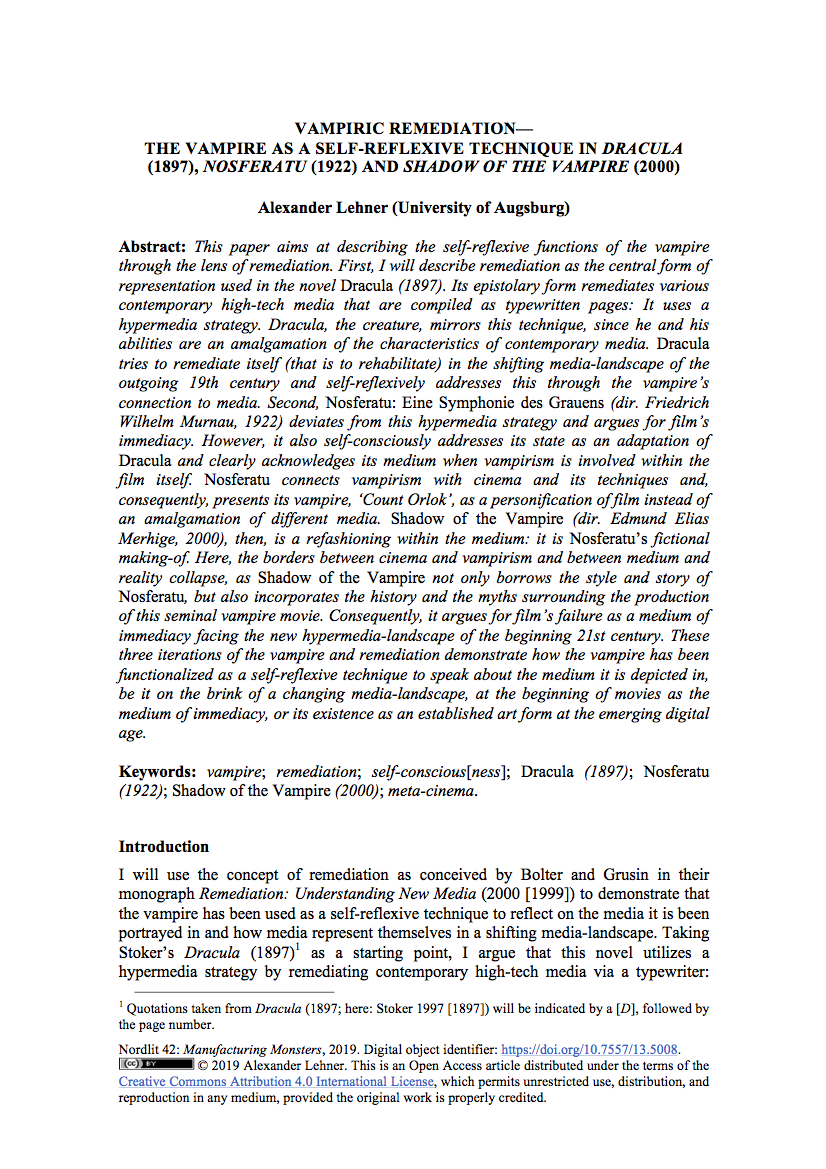Vampiric Remediation
The Vampire as a Self-Reflexive Technique in ‘Dracula’ (1897), ‘Nosferatu’ (1922) and ‘Shadow of the Vampire’ (2000)
DOI:
https://doi.org/10.7557/13.5008Emneord (Nøkkelord):
vampyr, remediation, selvbevisst[het], Dracula (1897), Nosferatu (1922), Shadow of the Vampire (2000), meta-kinoSammendrag
This paper aims at describing the self-reflexive functions of the vampire through the lens of remediation. First, I will describe remediation as the central form of representation used in the novel Dracula (1897). Its epistolary form remediates various contemporary high-tech media that are compiled as typewritten pages: It uses a hypermedia strategy. Dracula, the creature, mirrors this technique, since he and his abilities are an amalgamation of the characteristics of contemporary media. Dracula tries to remediate itself (that is to rehabilitate) in the shifting media-landscape of the outgoing 19th century and self-reflexively addresses this through the vampire’s connection to media. Second, Nosferatu: Eine Symphonie des Grauens (dir. Friedrich Wilhelm Murnau, 1922) deviates from this hypermedia strategy and argues for film’s immediacy. However, it also self-consciously addresses its state as an adaptation of Dracula and clearly acknowledges its medium when vampirism is involved within the film itself. Nosferatu connects vampirism with cinema and its techniques and, consequently, presents its vampire, ‘Count Orlok’, as a personification of film instead of an amalgamation of different media. Shadow of the Vampire (dir. Edmund Elias Merhige, 2000), then, is a refashioning within the medium: it is Nosferatu’s fictional making-of. Here, the borders between cinema and vampirism and between medium and reality collapse, as Shadow of the Vampire not only borrows the style and story of Nosferatu, but also incorporates the history and the myths surrounding the production of this seminal vampire movie. Consequently, it argues for film’s failure as a medium of immediacy facing the new hypermedia-landscape of the beginning 21st century. These three iterations of the vampire and remediation demonstrate how the vampire has been functionalized as a self-reflexive technique to speak about the medium it is depicted in, be it on the brink of a changing media-landscape, at the beginning of movies as the medium of immediacy, or its existence as an established art form at the emerging digital age.
Referanser
Abbott, Stacey. 2007. Celluloid Vampires: Life After Death in the Modern World. Austin: University of Texas Press.
Baeva, Elena. 2014. “As Gothic as It Gets? E. Elias Merhige’s Shadow of the Vampire: A Gothic Film on the Gothic Nature of Film”, in All that Gothic, edited by Agnieszka Łowczanin and Dorota Wiśniewska. Frankfurt am Main: Peter Lang, 259–271.
Bolter, Jay David, and Richard Grusin. 2000 [1999]. Remediation: Understanding New Media. Reprint edition. Cambridge: MIT Press.
Butzer, Günter. 2015. “Friedrich Wilhelm Murnau, Nosferatu: Eine Symphonie des Grauens”, in Große Werke des Films 1, edited by Günter Butzer and Hubert Zapf. Tübingen: A. Francke, 9–39.
Elsaesser, Thomas. 2009. “No End to Nosferatu (1922)”, in Weimar Cinema: An Essential Guide to Classic Films of the Era, edited by Noah William Isenberg. New York: Columbia University Press, 29–41.
Galini, Agia. 1986. “Vorwort”, in Grammophon[,] Film[,] Typewriter, authored by Friedrich A. Kittler. Berlin: Brinkmann & Bose, 3–6.
Gelder, Ken. 1994. Reading the Vampire. London: Routledge. Digital object identifier: https://doi.org/10.4324/9780203132050.
Gelder, Ken. 2012. New Vampire Cinema. London/Oxford: Bloomsbury Academic.
Gorky, Maxim. 1996 [1896]. “Review of the Lumière Presentation in Nizhni-Novgorod [sic; Nizhny-]”, in In the Kingdom of Shadows: A Companion to Early Cinema, as printed in Nizhegorodsky Listok, July 4, 1896; translated by Leda Swan, edited by Colin Handing and Simon Popple. London: Cynus Arts, 5.
Houswitschka, Christoph. 2005. “Burned to Light: Die Rezeption von F. W. Murnaus Nosferatu (1922) in E. Elias Merhiges Shadow of the Vampire (2000)”, in Der Fantastische Film: Geschichte und Fiktion in der Mediengesellschaft, edited by Oliver Jahraus and Stefan Neuhaus. Würzburg: Königshausen & Neumann, 61–81.
Joslin, Lyndon W. 2006 [1999]. Count Dracula Goes to the Movies: Stoker’s Novel Adapted, 1922–2003. Second edition of Count Dracula Goes to the Movies [a third edition followed in 2017]. Jefferson: McFarland.
Kaes, Anton. 2010. “The Return of the Undead: Weimar Cinema and the Great War”, in Weimar Publics/Weimar Subjects: Rethinking the Political Culture of Germany in the 1920s, edited by Kathleen Canning, Kerstin Barndt, and Kristin McGuire. New York: Berghahn, 31–41.
Keppler, Stefan. 2006. “Prolog zum Vampir: Paradoxierung und mediale Selbstreflexion in Literatur und Film”, in Der Vampirfilm: Klassiker des Genres in Einzelinterpretationen, edited by Stefan Keppler and Michael Will. Würzburg: Königshausen & Neumann, 7–29.
Kittler, Friedrich A. 1986. Grammophon[,] Film[,] Typewriter. With an introduction by Agia Galini. Berlin: Brinkmann & Bose.
Kittler, Friedrich A. 1993. Draculas Vermächtnis: Technische Schriften. Leipzig: Reclam.
Kittler, Friedrich A. 1995 [1985]. Aufschreibesysteme: 1800/1900. Third edition. München: Wilhelm Fink.
Kittler, Friedrich A. 1999 [1986]. Gramophone, Film, Typewriter. Translated, and with an introduction by Geoffrey Winthrop-Young and Michael Wutz. Stanford: Stanford University Press. Digital object identifier, referring to a shortened 1987 article version by Friedrich A. Kittler, Dorothea von Mücke, and Philippe L. Similon: https://doi.org/10.2307/778332.
Merhige, Edmund [E.] Elias (dir.). 2002 [2000]. Shadow of the Vampire. Feature film. DVD. Cologne: Splendid Entertainment.
Murnau, Friedrich Wilhelm [F. W.] (dir.). 2007 [1922]. Nosferatu: Eine Symphonie des Grauens. Feature film; written by Henrik Galeen. DVD. Munich: Transit Film.
Page, Leanne. 2011. “Phonograph, Shorthand, Typewriter: High Performance Technologies in Bram Stoker’s Dracula”, Victorian Network 3:2, 95–113. Digital object identifier not available: https://www.victoriannetwork.org/index.php/vn/article/view/27/30 [October 31, 2019].
Ruthner, Clemens. 2006. “Vampirische Schattenspiele: Friedrich Wilhelm Murnaus Nosferatu: Eine Symphonie des Grauens (1922)”, in Der Vampirfilm: Klassiker des Genres in Einzelinterpretationen, edited by Stefan Keppler and Michael Will. Würzburg: Königshausen & Neumann, 29–54.
Stoker, Bram. 1997 [1897]. Dracula: Authoritative Text, Contexts, Reviews and Reactions, Dramatic and Film Variations, Criticism. Critical edition by Nina Auerbach and David J. Skal. New York/London: W. W. Norton.
Weinstock, Jeffrey Andrew. 2012. The Vampire Film: Undead Cinema. London: Wallflower.
Wicke, Jennifer. 1992. “Vampiric Typewriting: Dracula and its Media”, ELH—English Literary History 59:2, 467–493. Digital object identifier: https://doi.org/10.2307/2873351.









